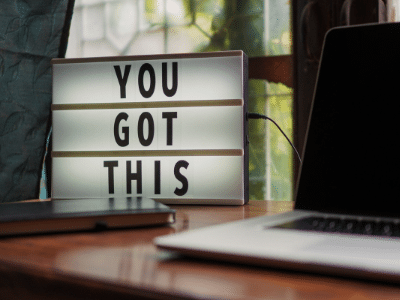

No matter who you are and what you want in life, you'll be aware that it's important to take control of your own destiny.
Luck and fate always influence the road you take, but to reach the greatest levels of success you need to learn how to sit comfortably in your own power.
Self-determination theory helps to explain what you need in order to be able to do this. But what is this theory, and how can you put it to use?
We'll begin with a thorough exploration of what self-determination theory actually is, explaining its history and unpacking the key terms.
Next, we'll introduce you to processes and techniques that can help you build self-determination in your own life, focusing on three major changes you can make to create a better life.
Finally, we'll close by asking how self-determination theory can also improve your Law of Attraction work, helping you manifest more effectively than ever before.

So, what is self-determination theory (SDT)? To begin, we need to define determination in this context. Essentially, determine where you're going in life, and the goals you pursue.
According to self-determination theory, we are all motivated to develop as people when we meet a set of 3 complimentary psychological needs – a connection between others and self, autonomy, and competence.
According to SDT, when our innate needs are met, we begin to take proper control of our lives, deliberately shaping our futures rather than seeing ourselves as victims of circumstance.
Crucially, SDT teaches that we do better when we move past external regulation – this is the drive to do things for a reward like love, approval, or acclaim Instead, we need to find our way to intrinsic motivation, where we learn to enjoy things in themselves.
These, however, are just the bare bones of the theory. To understand more, we need to explore the history of SDT.

The history of SDT began in the 1970s when psychologists began to understand the importance of drawing energy from our own desires and values (intrinsic motivation) as opposed to focusing on external improvements.
The crucial point in this research arrived around 1985 when Edward L. Deci and Richard Ryan published a monograph introducing the basics of SDT to the world. Since then, it has played a key role in both social psychology and educational theory.
Along with emphasizing the importance of intrinsic motivation, SDT has illuminated another major fact – that behavioral change is primarily driven by a need for growth.
In other words, we need to become actively invested in our own growth (which involves meeting challenges and moving out of our comfort zone) if we're going to create the life we want.
And, as noted above, we need three basic needs met if we're to be able to embrace growth:
Only once we have these three things will we be able to live a self-directed life.

How does the psychology of self-determination theory work in practice, then? Consider the following example. Imagine that you're leading a group project at work, and you fail to finish it on time.
If you're low in self-determination (because your three core needs have not been met), you will look outside of yourself for someone or something to blame.
Perhaps you'll adopt a victim stance, according to which you just “couldn't” get the work done, or maybe you'll blame someone else on the team.
Either way, you won't act to fix what went wrong, attempt to rebuild your reputation, or look inward to see what could be done differently next time.
In a nutshell, it's painful to take any ownership of what happened, so you'll defend yourself to the hilt.
In contrast, if you have high levels of self-determination, you will own up to where you made mistakes, while also acknowledging the role that other people or circumstances beyond your role may have played.
With the facts identified, motivation to make up for the failure will take over, and you’ll quickly recover. Those who react like this tend to have happier, more successful experiences, better relationships, and a stable internal source of self-esteem.
However, it's vital to note that your three core needs must be continuously met – otherwise, you too will run out of reserves of self-determination. So, whether you're low or high in self-determination, the tips below can help you make the best of your life.

Now that you understand what self-determination prescribes and have seen some self-determination examples, you may be excited to learn more.
However, if you're not yet motivated to pursue self-determination, it's worth noting that studies show it can improve your life in many key areas.
At work, self-determination gets you promoted more quickly, and helps you build good alliances with others. In competitive settings, self-determination pushes you to excel and allows you to thrive in the mastery of your skills.
Meanwhile, in your social life, self-determination pushes you to sustain a healthy community of people who genuinely add positivity to your life.
And there is even research suggesting that high levels of self-determination are correlated with better adherence to a diet and exercise regime!
Here, then, are three powerful strategies you can use to keep your self-determination high at all times.
You'll notice the most significant improvements if you try to apply all of these at the same time, but even just focusing on any one strategy should lift your mood and begin to open your mind to new opportunities.

Firstly, you want to start improving self-motivation skills – learning how to draw from an intrinsic source of motivation rather than relying on others for approval.
This integrated motivation will then keep you moving even when life becomes challenging.
SDT theory teaches that daily goals help with this.
In your first week, these goals can be very simple.
You could include things like tidying your desk or making a call to the doctor.
In the next week, try to add one more challenging goal every day.
An example of a challenge would be, speaking first in a meeting, or approaching someone about a new work opportunity.
Keep challenging yourself more, week by week.

Secondly, you will benefit from increasing awareness of your own power to positively influence life's outcomes.
One way in which you can do this effectively is to look back at your own history and challenge yourself to see where you have been in control of major positive changes.
Can you think of 5-10 times where it was your drive, responsibility, and intuition that made something happen?
You can include anything on the list, from being the first person to ask another out on a date to coming up with an out-of-the-box solution at work or ending a relationship that wasn't serving your needs.

Thirdly, remember that it is up to you to make your life a success and to tackle the roadblocks that arise – this can be empowering in time, rather than scary.
The goal-setting exercise helps here, boosting your confidence as you become more intrinsically motivated.
However, you can go even further by keeping a journal in which you practice taking responsibility for each day.
In each entry, think of one good thing that happened through your will and behavior, and what made it work out.
Next to that, write one thing that didn't work out so well, and what you'd do differently.
The goal of self-determination psychology is growth, not self-recrimination.

You've now learned all the basics of self-determination theory (SDT), including uncovering the basic needs that must be met for you to thrive as a person.
You've also seen some concrete steps you can take to boost self-determination in your daily life. Now that you've got all of this under your belt, you can move on to complementary theories that help you to improve your confidence and success even more.
The Law of Attraction is an ideal partner for self-determination theory. According to the Law of Attraction, like attracts like, so if you work on taking control then the universe will give you more opportunities to do so.
In contrast, if you revert to a victim mentality, you'll attract negativity and find yourself feeling continuously smaller.
Happily, Law of Attraction practitioners has created a wide range of tool kits and techniques that boost your self-determination and improve your ability to attract the things you really want into your life.
This is called using manifestation power, and those who become good at it swear that it can transform lives. As a bonus, the most powerful techniques are also easy and intuitive.
For example, one exercise – creative visualization – helps you build a vivid image of your desires, concentrating your energy on turning them into reality.
You can think of this as a kind of super-powered meditation exercise, with tangible results on the direction of your life.
Meanwhile, others focus on affirmations – positive, focused statements that you say to yourself in order to change the way you see your worth and the world around you.
However, this is just a snapshot of what the Law of Attraction can do for you.
If you want to become happier, stronger, and more creative than ever before, reading more about manifesting is the perfect place to start.
